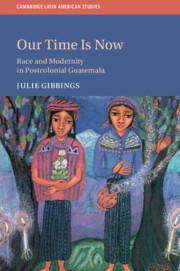Book contents
- Our Time Is Now
- Cambridge Latin American Studies
- Our Time Is Now
- Copyright page
- Dedication
- Contents
- Maps, Figures, and Tables
- Acknowledgments
- Introduction
- Part I Translating Modernities
- Part II Aspirations and Anxieties of Unfulfilled Modernities
- 5 On the Throne of Minerva
- 6 Freedom of the Indian
- 7 Possessing Tezulutlán
- 8 Now Owners of Our Land
- Conclusion
- Glossary
- Index
- Cambridge Latin American Studies (continue from page ii)
5 - On the Throne of Minerva
The Making of Urban Modernities, 1908–1920
from Part II - Aspirations and Anxieties of Unfulfilled Modernities
Published online by Cambridge University Press: 01 July 2020
- Our Time Is Now
- Cambridge Latin American Studies
- Our Time Is Now
- Copyright page
- Dedication
- Contents
- Maps, Figures, and Tables
- Acknowledgments
- Introduction
- Part I Translating Modernities
- Part II Aspirations and Anxieties of Unfulfilled Modernities
- 5 On the Throne of Minerva
- 6 Freedom of the Indian
- 7 Possessing Tezulutlán
- 8 Now Owners of Our Land
- Conclusion
- Glossary
- Index
- Cambridge Latin American Studies (continue from page ii)
Summary
Chapter 5 examines urban beautification efforts, welfare associations, liberal clubs, and staged state theater (e.g., the Minerva festivals) during Manuel Estrada Cabrera’s dictatorship (1898–1920). If state sovereignty was circumscribed by the coffee planters’ efforts in the countryside, in the city of Cobán, Estrada Cabrera responded to popular demands for access to civilization by staging elaborate festivals that provided all Guatemalans access to Western civilization and learning.The ladino nationalism that flourished under Estrada Cabrera blurred racial boundaries and held up the ladino artisan as the ideal national subject. A series of national and global events – earthquakes, World War I, the Mexican and Russian Revolutions, and the 1919 influenza pandemic – upended these efforts and transformed the Minerva festivals from symbols of national inclusion and modern belonging into symbols of the corruption and political discontent that erupted in 1920 with the overthrow of Estrada Cabrera.
Keywords
- Type
- Chapter
- Information
- Our Time is NowRace and Modernity in Postcolonial Guatemala, pp. 191 - 230Publisher: Cambridge University PressPrint publication year: 2020

